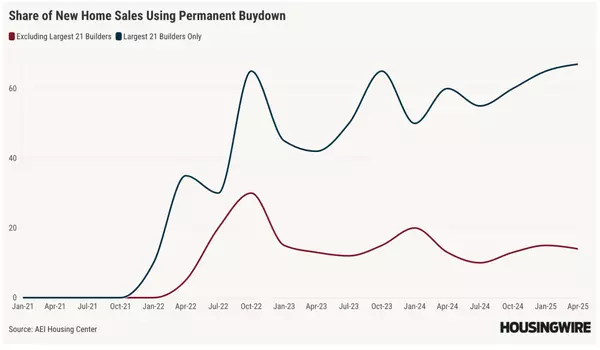The AI advantage: How real estate industry leaders can get ahead in a digital market

Artificial intelligence (AI) is no longer a future promise in real estate. It’s here, measurable, and rapidly transforming how professionals work. From agents juggling client demands to lenders navigating compliance and efficiency pressures, AI is already proving itself both a pressure valve and a p
Read MoreRedefining the loan officer’s toolkit: Why insurance guidance belongs next to APR calculators

A mortgage is more than a rate and a closing date. It is a family planning for what happens after the keys are in hand. That is why insurance is not optional and belongs beside pricing, product fit, and closing costs in a loan officer’s core toolkit. It is required for the loan, and it also shapes m
Read MoreFinancially stressed homeowners are delaying essential repairs

A growing number of homeowners are putting off necessary maintenance and repairs, leading to safety concerns, higher costs and long-term financial strain, according to a new report from Bold North Roofing. The study found that 71% of homeowners have postponed at least one home project in 2025 — and
Read MoreColdwell Banker affiliate changes ownership in West Virginia

Coldwell Banker Yost — a longtime real estate firm serving southern West Virginia — has been acquired by Nathan Hendrick and will operate under the new name Coldwell Banker Hendrick Real Estate. The acquired company has operated in West Virginia for more than 25 years and was previously owned by Ste
Read MoreFed prepares to pivot balance sheet, with potential ripple effects for mortgages

A growing number of economists believe that the Federal Reserve is close to announcing the end of its quantitative tightening (QT) program — a move that could have wide-reaching implications for the mortgage industry. Over the past few weeks, central bank officials have signaled they are prepared to
Read MoreOptimal Blue comes out swinging on price-fixing lawsuit

Optimal Blue has responded to a class action lawsuit filed against it and 26 mortgage lenders, calling the claims “baseless” and “frivolous” and vowing to fight the lawsuit “all the way through.” “Optimal Blue is aware of the complaint filed against it, Black Knight, Inc., and many of the largest mo
Read MoreSexual assault lawsuit plaintiffs accuse eXp of fraudulent misrepresentation

Roughly two and a half years since filing their initial complaint, the Acevedo sexual assault plaintiffs are back with their third amended complaint. In the latest rendition of the complaint, eXp World Holdings, eXp Realty, eXp founder and CEO Glenn Sanford, suspended eXp agent David Golden, now-fo
Read MorePartnerOne to acquire Mortgage Cadence

Software group PartnerOne announced on Tuesday that it has entered into an agreement with Accenture to acquire Mortgage Cadence, a provider of cloud-based digital lending solutions. PartnerOne said in its press release that it focuses on acquiring firms for the long term and investing to strengthen
Read MoreWill the Fed ruin the lowest mortgage rates of 2025?
Happy lowest-mortgage-rate-of-the-year day on this Halloween week! Mortgage rates are currently at a yearly low right before the Fed meets so the question is: will Fed Chair Jerome Powell ruin the good news right before Halloween festivities? Whatever Powell says tomorrow, mortgage rates are behavin
Read MoreMaking the 7-Day refi reality: Instant title, done right

The refinance experience is only as fast as its slowest step, and title insurance has traditionally been one of the least understood steps in the process – and, therefore, perceived as one of the most unpredictable. But the right technologies are making it possible to deliver instant title decisions
Read MoreZillow launches messaging, a new way for home shoppers to collaborate within the Zillow app

Collov AI, Side partner on virtual staging tools for agents

Collov AI, an artificial intelligence (AI) platform for home design, announced a partnership with Side, a white-label real estate brokerage platform. The move expands access to Collov AI’s staging and visualization tools for Side’s network of more than 500 boutique real estate companies — with tools
Read MoreLuxury homebuyers getting more bang for their buck in Atlanta, Denver
While the national entry point for luxury homes edged down slightly in September, buyers with a million-dollar budget can find significantly more space in some regions than others, according to Realtor.com’s latest Housing Market Luxury Report. The report shows that in metros such as Atlanta, Denver
Read MoreRenters are moving more than homeowners, but US mobility is historically low

Americans are moving less than at any point in the past 50 years, according to recent U.S. Census Bureau data analyzed by Point2Homes. In 2024, only 11% of Americans — or roughly 37 million residents — changed their address. That’s down from 14.3% a decade earlier and nearly half the rate of the 196
Read MoreNextHome partners with Workman Success Systems, promotes executives

NextHome is strengthening its agent and broker training program. On Monday, the firm announced that it was teaming up with Workman Success Systems to launch NextHome Growth Lab. According to the company, this initiative unites AI-powered tools, live coaching and performance accountability in one pla
Read MoreXactus announces partnerships for income, employment verification efforts

Xactus, a fintech company specializing in mortgage verification solutions, has announced three new integrations designed to enhance its Intelligent Verification Platform, Xactus360. The partnerships with Thomas & Co., Argyle and Plaid aim to expand lender access to real-time income, employment and a
Read MoreFourth generation of Hunt family takes over HUNT Real Estate

A fourth generation of the Hunt family is taking over the HUNT Real Estate Corp., which owns and runs HUNT Real Estate ERA. On Monday, current CEO Peter Hunt announced that his son Charlie Hunt would be taking over the Buffalo, New York-based firm as its new CEO. Charlie Hunt first joined his famil
Read More9 top places to buy mortgage leads in 2025

Mortgage origination in 2025 is all about balance between automation and personal connection, speed and long-term strategy. While referrals and repeat clients remain core drivers, buying mortgage leads and investing in lead generation have become an essential way to maintain steady volume year-round
Read MoreBeeline Loans pioneers blockchain home equity transactions

Beeline Holdings announced that its subsidiary, Beeline Loans, has completed its first blockchain-recorded BeelineEquity transactions, becoming the first U.S. platform to tokenize residential home equity at scale. In its initial rollout, BeelineEquity finalized five blockchain-tracked home equity tr
Read MoreBroker working group pushes for change at NAR

A group of brokers has banded together in hopes of inciting change at the National Association of Realtors (NAR). The Pro-Agent Restore Trust in NAR Working Group was formed in April 2025 and has 15 members, according to Real Estate News, which first reported the story. The group consists of CEOs a
Read More
Categories
Recent Posts










